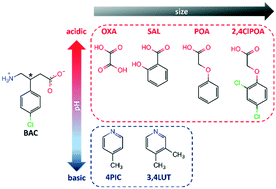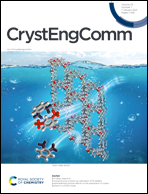Multicomponent crystals of baclofen with acids and bases—conformational flexibility and synthon versatility†
Abstract
Baclofen (BAC, (R/S)-4-amino-3-(4-chlorophenyl)butanoic acid), was used to form multicomponent crystals (MCCs) with coformers (CFs) of different acidic strength and molecular size. The crystallisation of BAC with oxalic acid (OXA), salicylic acid (SAL), phenoxyacetic acid (POA), 2,4-dichlorophenoxyacetic acid (2,4ClPOA), 4-picoline (4PIC) and 3,4-lutidine (3,4LUT) yielded seven MCCs. The bulk materials were analysed by thermoanalytical methods (thermogravimetry and differential scanning calorimetry), powder X-ray diffraction analysis and Fourier transform infrared spectrometry. Liquid assisted grinding was also applied to form the MCCs. X-ray analysis of the single crystal structures revealed that BAC exists in zwitterionic or cationic form, and the MCCs represent a large variety of crystal classes, such as salts, salt solvates, cocrystal salt solvates or solvates with different stoichiometry. It was noted that BAC appeared in many different conformations in the MCCs, but comparative crystal packing analysis revealed similarities in the packing arrangement of the MCCs. This structural feature can be used for crystal engineering purposes when MCCs of BAC are designed.

- This article is part of the themed collections: Host‒Guest chemistry: in honour of Luigi Nassimbeni’s 9th decade and Crystal Engineering Techniques


 Please wait while we load your content...
Please wait while we load your content...